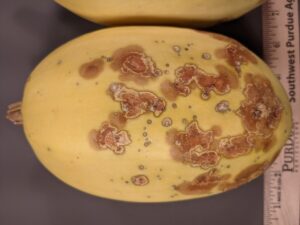The photo here (Figure 1) shows a spaghetti squash with many lesions on the fruit. At first glance, it may seem to be several lesions of different sizes. However, if one looks closely, there are actually two different diseases on the fruit.
The larger, brown, irregular water-soaked areas are black rot, caused by the same pathogen that causes gummy stem blight. The smaller, round, slightly depressed lesions are bacterial spot. Unfortunately, the biology and management of these diseases are quite different.
Black rot is caused by a fungus that may survive in crop residue or on seed or transplants. In addition to causing lesions on fruit, the same pathogen can cause economically important lesions on foliage as well (the disease is known as gummy stem blight on foliage and black rot on fruit). Gummy stem blight is an important pathogen of cantaloupe and watermelon. Black rot and gummy stem blight can be managed with crop rotation and fall tillage. Manage black rot with a combination of contact fungicides such as chlorothalonil and mancozeb products and systemic fungicides such as Luna Experience®, Miravis Prime®, tebuconazole products and several premixes.
Bacterial spot of cucurbits (not caused by the same pathogen as causes bacterial spot of tomato) may also survive in crop residue or seed or transplants. However, the lesions on leaves are not economically important. This disease is important on squash and pumpkin, but less so on other cucurbits. Crop rotation and fall tillage are important management considerations. Products with copper as an active ingredient such as copper hydroxide and copper sulfate will help to lessen disease severity. Tank mix copper products with mancozeb products and start applications when fruit are at about softball stage.
Another important aspect of disease management is proper diagnosis. The sample shown here might be difficult to diagnose without sending it to a plant diagnostic lab such as the Purdue Plant and Pest Diagnostic Laboratory.
